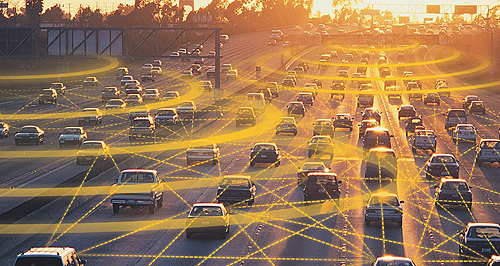News - ToyotaToyota rolls out V2V tech in USTalk is cheap: Toyota will fit vehicle-to-vehicle tech systems to its fleet of vehicles – including Lexus – in the US from 2021. More vehicles to talk to each other as Toyota confirms V2V and V2I tech from 202117 Apr 2018 TOYOTA will fit Dedicated Short-Range Communications (DSRC) systems on all of its vehicles sold in the United States kicking off in 2021, as part of its plan to ramp up the rollout of automated technology. The goal was to have the systems fitted to all Toyota and Lexus models by the mid-2020s and the company says it marks a new step in “creating a safer and more efficient driving ecosystem while advancing connected and automated technology deployment”. DSRC systems enable vehicle-to-vehicle (V2V) and vehicle-to-infrastructure (V2I) communications and it supports the broadcast of vehicle information such as location, speed and acceleration several times per second. The information can be used by other DSRC-enabled vehicles to help prevent collisions, and it can facilitate communications including real-time information such as slow or broken-down vehicles, traffic hazards, poor road conditions, signs and signals that may otherwise be difficult for the driver to see. DSRC uses seven channels on the 5.9 GHz spectrum band that is a dedicated intelligent transport systems (ITS) band and given it does not use a mobile phone or data network, it does not incur any mobile data charges. As DSRC is based on industry standards, Toyota vehicles will be able to communicate with vehicles built by other car-makers. Toyota says DSRC technology, along with sensors radars and cameras and on-board sensor tech “to help make automated vehicle systems for customers safer, more reliable and more enjoyable”. The car-making giant says it has also worked with the US department of transport, other car-makers and infrastructure companies to develop DSRC V2X communications tech over the past 13 years Toyota has called on all automotive manufacturers and transport infrastructure companies to “quickly commit to DSRC technologies in the US to realise the full safety and traffic flow benefits of this technology”. Toyota Motor North America (TMNA) CEO Jim Lentz said the rollout of the technology would ultimately make cars safer. “By allowing vehicles’ intelligent systems to collaborate more broadly and effectively through DSRC technology, we can help drivers realise a future with zero fatalities from crashes, better traffic flow and less congestion,” he said. “Three years ago, we pledged to have automatic emergency braking (AEB) in almost every vehicle we sell by the end of 2017. Today, 92 per cent of all Toyota and Lexus vehicles sold in the US have Toyota Safety Sense or Lexus Safety System + with AEB standard, and other auto-makers’ deployment of this life-saving technology is accelerating, three years ahead of the 2022 industry target. “In that same spirit, we believe that greater DSRC adoption by all auto-makers will not only help drivers get to their destinations more safely and efficiently, but also help lay the foundation for future connected and automated driving systems.” General Motors announced early last year that it would roll out V2V technology to its range of Cadillac models in the US, starting with the CTS that would be fitted with a system developed by Adelaide-based tech company, Cohda Wireless. Meanwhile, Volkswagen announced in June last year that it would deploy the same technology in Europe starting in 2019. Late last year, the Australian Communications and Media Authority (ACMA) issued regulations to support the rollout of ITS in Australia, with the body confirming the allocation of the 5.9GHz band Down Under, keeping it in line with the US and the European Union.  Read more |
Click to shareToyota articlesResearch Toyota Motor industry news |

















Facebook Twitter Instagram